Salmon fishers on Whidbey Island might find a saltwater fishing license to be a slightly better investment this year.
Some, however, may still dispute that.
State Fish and Wildlife set its 2017 salmon fishing seasons this week, giving anglers around the island slightly better news in regard to catching hatchery coho in Puget Sound.
Last year, nearly all of Puget Sound — and all waters around Whidbey — was closed to recreational coho fishing.
This year, the state is allowing limited opportunities in some areas around Whidbey for coho and pinks while restricting it all together in others.
The culprit is unfavorable environmental conditions in recent years, such as warm ocean water and drought in rivers, which have reduced the number of salmon returning to Washington waters, according to Kyle Adicks, salmon policy lead for the state.
“We’re in the third year of a multi-year downtown in salmon returns,” Adicks said. “Similar to last year, we faced significant challenges in crafting fisheries.”
Opportunities for chinook in Puget Sound marine areas will be similar to last year.
In Marine Area 9, a popular span on the west side of the island that covers Admiralty Inlet, salmon fishing is scheduled to be open from July 16 through Aug. 15 but with a higher quota for chinook than in 2016.
The fishing season for coho and pinks, however, will be extended through Labor Day in Marine Area 9, but only for shore anglers.
“With the bad coho runs, we were trying to find a way to keep portions of Area 9 open,” Adicks said. “The shoreline made sense.
“You won’t be able to fish from a boat for salmon after August 15 in Area 9.”
Pink salmon, which return to their native rivers only during odd-numbered years, typically offer the best opportunity for anglers to catch a salmon from the beach.
Anglers line up by the dozens along the shores of Keystone Spit, near Coupeville, and at Bush Point in Freeland, casting pink Buzz Bombs and Rotators.
This year’s pink return to Puget Sound is projected to be drastically lower than usual. This year’s run is expected to be 1.15 million, about 80 percent lower than the 10-year average
Coho are normally the last to return from the ocean to Puget Sound, arriving in abundance in late summer, peaking in August and September but still around in October.
About 559,000 Puget Sound coho are forecast this year, down about 6 percent from the 10-year average, though it is slightly higher than last year’s forecast.
Opportunities for hatchery coho will be reduced this year to limit impacts on wild coho stocks bound for the Skagit and Stillaguamish rivers, Adicks said.
There will be no coho fishing in the Skagit River this year, he added.
Whidbey Island is surrounded by four different marine areas (6, 8-1, 8-2 and 9) that contain different rules and a fifth marine area (7) that begins offshore a short distance from Deception Pass.
One of the toughest pills to swallow for Whidbey anglers this year will be in Marine Areas 8-1, which includes popular North Beach at Deception Pass, Hope Island, Skagit Bay, Oak Harbor, Penn Cove and Holmes Harbor.
Marine Area 8-1 will be completely closed to coho and pink salmon this year and won’t open for hatchery chinook until November, Adicks said.
Marine Area 8-2, which covers Ports Susan and Gardner, also will be mostly shut down this summer.
In Marine Area 8-2, anglers will have to wait until November to fish for chinook and won’t be able to fish for pinks. However, shore anglers will be allowed to fish for coho Aug. 1-Sept. 4 from a small stretch of beach on the southwest corner of Possession Point, Adicks said.
Marine Area 6, which includes a long stretch of Whidbey’s west side, will be open for hatchery chinook, coho and pinks from July 1-Aug. 15, then closed for salmon until next March.
In Marine Area 7, which involves the San Juan Islands, anglers may participate in selective fishing for chinook in July, then switch to non-selective fishing for chinook from Aug. 1-Sept. 30, Adicks said. There will be no coho retention in Marine Area 7 but pinks may be caught any time when the fishery is open for chinook.
Marine Area 7 will reopen for selective winter blackmouth January through next April or until the quota is met.
Anglers may have to wait another two years to see stronger runs make way for greater recreational fishing opportunities, Adicks said.
The coho forecast for 2018 isn’t much better than last year based on indicators.
“There are a lot of unprecedented things going on in the ocean with the warm blob,” Adicks said. “We expected poor returns to continue into last year and into this year.
“Coho return as 3-year-olds. Fishing for coho next year will likely be pretty bad because of the low number that came back in 2015.”
(This story was originally published Wednesday, April 12, 2017)



